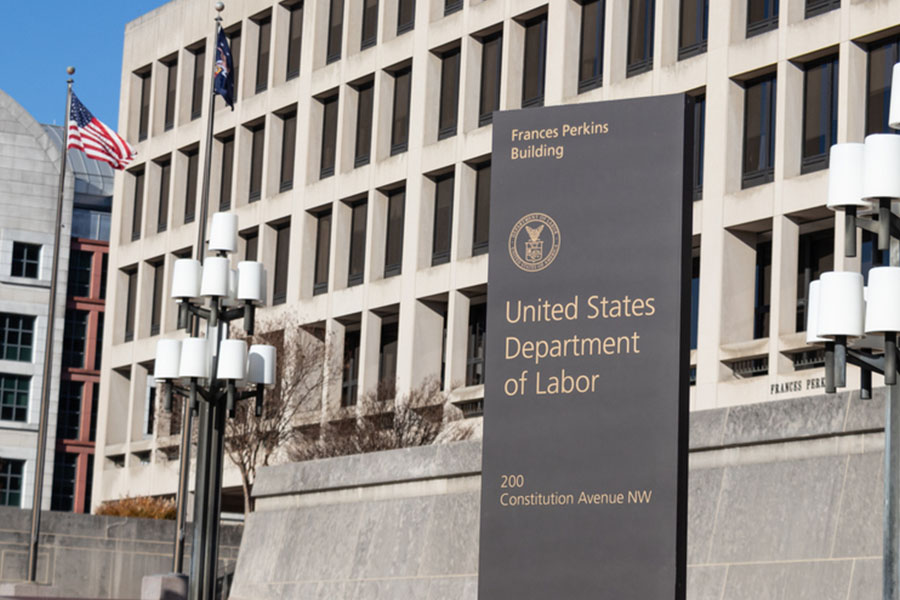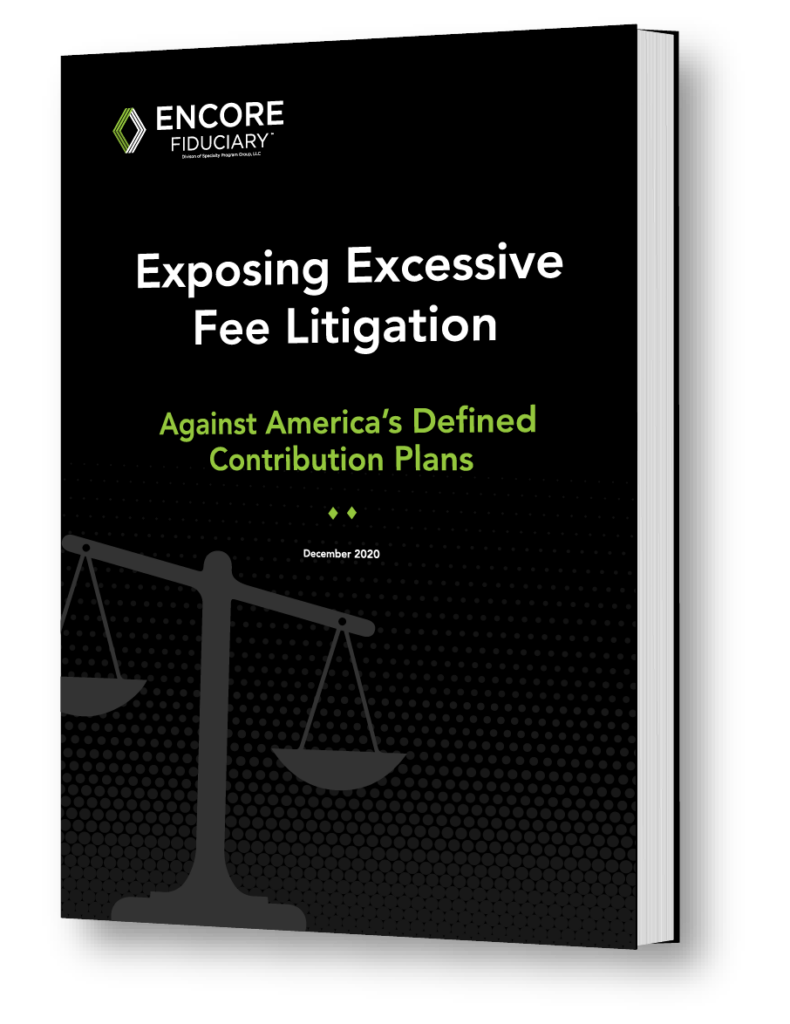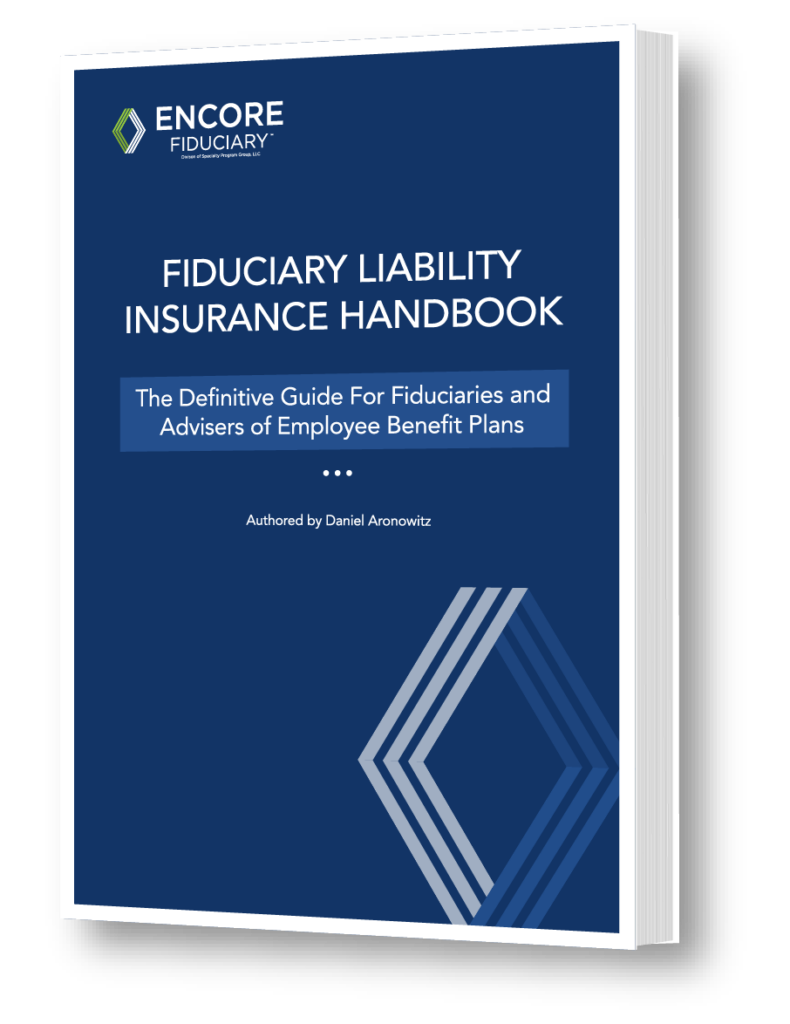For the past decade, while hundreds of ERISA lawsuits have been filed against employers, one very important question has loomed over this very troubling landscape. Why has the Department of Labor (DOL), which is responsible for overseeing our nation’s private retirement system, been silent (or unhelpful) while lawsuit after lawsuit threatens to undermine that very system?
As the Fid Guru Blog has previously written, DOL’s inaction during this period effectively amounted to regulation through litigation – something that the drafters of ERISA never envisioned. In fact, the drafters designed ERISA precisely to minimize regulation by litigation, such as by preempting state laws and designing a targeted set of remedies. As we have come to learn in recent months, DOL was sharing information that it had obtained through its own investigations with plaintiffs’ firms. This practice, which was discovered at the end of last year and carried out through so-called “common interest agreements” in at least a dozen investigations, has rightly sparked outrage from the regulated community and on Capitol Hill. As one court put it, DOL’s information sharing with plaintiffs’ firms is troubling because it effectively enables DOL “to weaponize private litigation against” private parties and “litigate in the shadows.” Since its discovery, this concerning practice has been the subject of a congressional hearing and proposed legislation – the Balance the Scales Act (H.R. 2958) – which was recently approved by the House Committee on Education and Workforce
Rather than fulfilling its statutory responsibilities by clarifying the meaning and scope of ERISA, and even when otherwise consistent with its own longstanding precedent, DOL let plaintiffs’ lawyers test novel theories of liability and aggressively pursue settlements, absent any showing of wrongdoing. ERISA’s private cause of action is a powerful tool for participants who have been harmed by plan mismanagement. And, when applied correctly, it is an important tool for righting wrongs. It was not, however, ever intended to displace DOL’s critical role in regulating our nation’s voluntary system of employee benefit plans.
Key Point #1 – DOL Is Starting to Push Back Against Harmful Litigation
Given these concerning realities, it has been very encouraging to see, in recent months, what appears to be the start of an effort by DOL to wrestle its regulatory authority back from the plaintiffs’ bar and the courts that have incorrectly accepted expansive views of ERISA’s scope and meaning. Specifically, in a pair of recent developments where DOL has traditionally been inactive or unhelpful, it has taken two very important actions to help curb the abusive litigation that has exploded in recent years.
- Forfeiture Amicus Support: First, on July 11, 2025, DOL filed an amicus brief in support of one of the dozens of employers who have been sued for allocating plan forfeitures to reduce future employer contributions, when the plan otherwise permits those amounts to offset administrative expenses. Despite longstanding IRS guidance and legislative history endorsing this practice, plaintiffs have argued that this use of forfeitures should somehow be viewed as a per se violation of ERISA. In its recent brief to the Ninth Circuit, however, DOL correctly rejected the plaintiffs’ arguments, explaining that their conclusory allegations and suggestions that fiduciaries are required to provide contributions and benefits that are not promised by the plan fail to state a claim for a fiduciary breach under ERISA.
This is a remarkable development given the fact that we are unable to recall the last time that DOL filed an amicus brief in defense of an employer when faced with a participant lawsuit under ERISA. Until now, DOL has virtually always supported plaintiffs or, just as troubling, remained silent when plaintiffs filed meritless lawsuits against plan sponsors. Whether through this action or inaction, DOL’s effective regulation through litigation has failed to fulfill its responsibilities under ERISA and inappropriately deputized plaintiffs’ attorneys to clarify what is required and prohibited by the law. DOL’s forfeiture brief comes at an especially helpful time, as these forfeiture cases have just begun to reach the federal courts of appeal.
- Morgan Stanley Advisory Opinion: Second, on September 9, 2025, DOL issued Advisory Opinion 2025-03A, ruling that a long-term incentive compensation plan (LTICP) offered by Morgan Stanley to its employee-advisors is not an ERISA-covered pension plan simply because it allows, in a limited set of circumstances, for awards to be paid upon termination. This is a very important development for the countless employers who offer these types of arrangements, including Morgan Stanley, as it should help to deter would-be plaintiffs from pursuing future lawsuits and arbitrations that seek to extend ERISA’s vesting (and other) rules where they were never intended to apply. While this Advisory Opinion focuses on a special type of employee benefit plan that is unlike the more familiar retirement and health plans that have been plagued by ERISA litigation in recent years, it is nevertheless an excellent indication of DOL’s new desire to curb the harmful impacts of improper ERISA litigation.
As discussed further in this post, the Morgan Stanley Advisory Opinion did not simply appear out of thin air. Rather, there was a recent court ruling in which a federal district court incorrectly and unnecessarily held that ERISA applies to Morgan Stanley’s LTICP because, in a limited set of circumstances, it pays employees upon termination. If left unchecked, that ruling’s analysis not only threatens to create substantial liabilities for Morgan Stanley, it also threatens to extend ERISA’s vesting (and other) requirements to compensation arrangements that it was never intended to cover. Such a result would effectively open up new targets for the plaintiffs’ bar. Accordingly, by issuing this Advisory Opinion now, DOL was able to use one of the tools at its disposal to clarify and confirm current law, thus helping deter a new wave of ERISA lawsuits that would severely penalize employers for relying on longstanding and correct regulatory and judicial interpretations defining the boundaries of ERISA.
Key Point #2 – Unprecedent Expansions of ERISA Would Have Disastrous Consequences
ERISA is a robust and comprehensive regulatory regime that, when properly applied to pension and welfare plans, dictates how they must be designed, imposes strict fiduciary duties on those responsible for plan management, requires detailed disclosure and reporting, and prescribes specific mechanisms for dispute resolution. ERISA, however, was not intended to cover every conceivable compensation program between employers and employees. ERISA was not, for example, ever intended to cover the type of LTICP that Morgan Stanley offers to its employee-advisors. This is because, as discussed further below, it is neither a pension plan nor a welfare plan.
LTCIPs, which are especially common in the financial services industry, are designed to compensate current employees as rewards for performance and retention; not to provide retirement benefits. Moreover, not only do these types of plans fall outside of compliance with ERISA, in operation, they really can’t be designed as ERISA-compliant plans. This is because, among other reasons, they cannot comply with ERISA’s vesting rules and they are, in ERISA parlance, “unfunded.” Their very nature depends on delayed vesting as an incentive for current employees to remain employed, thus making vesting rules unworkable, and making funding inappropriate.
So how does this type of plan work? Very generally, and putting aside a number of details for the sake of simplicity, employees receive a right to a future compensation award that is based on a variety of factors, such as their prior performance and years of service. This right is provided in addition to regular compensation and benefits. While the amount of each employee’s award is based on these factors, the award may be forfeited or cancelled if the employee voluntarily leaves the employer before a certain number of years or if the employee engages in prohibited activity, such as financial misconduct. In this regard, the award is technically not earned until the employee completes the service period and satisfies all of the other conditions. To avoid overly punitive forfeitures, these plans commonly provide an exception to the service period in the event of death, disability, retirement, layoffs, and departures for government service. If, and only if, the employee satisfies all the award conditions or qualifies for one of the exceptions, the award vests and is immediately paid to the employee. So, for example, if an individual reaches their vesting date as a current employee at age 35, the award is paid at age 35. Employees do not have a right to defer the award until their retirement.
The lawsuits and arbitrations that have been filed against Morgan Stanley and similar companies with these programs have been brought by former employees who voluntarily left employment before completing the requisite period of service and, therefore, forfeited their awards. The claim is that, despite existing precedent from DOL and the courts indicating that these programs are not ERISA-covered plans, they should be treated as ERISA-covered pension plans that are subject to ERISA’s vesting rules. Because the former employees pursuing these claims typically have many years of service that would require 100% vesting if covered by ERISA, the argument is that any forfeitures violate the law and must be paid out.
The recent attempts to expand ERISA’s protections to these incentive programs through litigation and arbitration have been misguided and, if successful, would have disastrous consequences for employers and employees alike. For example, if ERISA is improperly stretched to cover Morgan Stanley’s LTICP, Morgan Stanley would be required to pay awards to employees who never satisfied the award conditions, would retroactively be required to award millions of dollars in unearned compensation, and would be discouraged, if not prohibited, from offering these types of employee incentives in the future. Such a result would unfairly penalize employers for relying on longstanding precedent from DOL and the courts and prevent employees from benefiting from these programs.
Furthermore, this specific attempt to test the boundaries of ERISA by applying its reach in unexpected and novel ways is only one part of the broader wave of ERISA litigation that has been so harmful over the past decade. Even for employers who do not offer these types of incentive plans, this is very troubling as nothing prohibits plaintiffs’ attorneys from using the proceeds that they collect from one type of litigation to fuel new lawsuits in other contexts, such as the traditional fee and performance claims.
Key Point #3 – Programs That Pay at Termination Are Not Automatically Pension Plans
ERISA is only designed to cover two types of employee benefit plans: (1) “pension plans;” and (2) “welfare plans,” such as health and life insurance plans. The controversy surrounding Morgan Stanley’s LTICP revolves around whether that plan is a pension plan. So, in this post, we focus exclusively on how ERISA defines pension plans and how the misapplication of that definition eventually led to the need for DOL’s recent Advisory Opinion.
ERISA section 3(2) defines a pension plan to mean any plan that, by its express terms or as a result of surrounding circumstances, “(i) provides retirement income to employees, or (ii) results in a deferral of income by employees for periods extending to the termination of covered employment or beyond.” ERISA’s pension plan definition is a term of art and each of its elements must be applied with an understanding of what ERISA was intended and not intended to cover.
For example, ERISA’s definition of pension plan is broader than the Internal Revenue Code’s definition of “pension” plan. ERISA’s definition not only covers defined benefit plans and money purchase plans, it also covers defined contribution retirement plans. ERISA’s definition does not, however, extend to every conceivable arrangement where an employer pays compensation to an employee at termination or a later date. As courts have astutely recognized in the past, ERISA’s definition of pension plan “is not algorithmic” and it should not be “read as an elastic girdle that can be stretched to cover any content that can conceivably fit within its reach.” Instead, courts must look to the purpose of ERISA and the purpose of the plan in determining whether ERISA’s protections should apply to any particular arrangement.
Through previous DOL guidance and court rulings, it has long been understood that programs intended to reward current employees with current compensation are not “pension” plans.[1] These types of awards are not intended to provide retirement income and are not intended to provide deferrals of income extending to termination or beyond. Furthermore, as DOL recently confirmed through Advisory Opinion 2025-03A, it has long been understood that these types of programs are not automatically converted into ERISA-covered pension plans simply because they allow payments, which would otherwise be made on a specified date, to be paid earlier in the event that an employee terminates.
This critical distinction is appropriately informed by an understanding of what ERISA was and was not intended to do. While ERISA was intended to ensure that retirees receive all bona fide pension benefits that are owed to them, as one court recently reiterated in a case challenging an LTICP offered by Bank of America, it was not “intended to hamstring or dissuade an employer” from designing other types of programs, “such as retention or other bonus programs, tailored to their particular workforce or industry.”
This distinction, however, was recently disregarded and called into question through a 2023 district court ruling, Shafer v. Morgan Stanley, which incorrectly held that Morgan Stanley’s LTICP should be treated as an ERISA-covered pension plan simply because it provided for payments upon termination in the event of death, disability, retirement, layoffs, and departures for government service. Rather than approaching this threshold definitional issue with an appreciation for ERISA’s history and purpose, and with an eye towards the harmful consequences of such a ruling, the court used an overly simplistic application of ERISA’s definitions to incorrectly treat Morgan Stanley’s LTICP for current employees as a pension plan subject to all of ERISA’s requirements. Morgan Stanley appealed this ruling but, on procedural grounds, the Second Circuit refused to consider the appeal.
As noted above, Advisory Opinion 2025-03A is a very helpful response to the Shafer ruling as it reaches the exact opposite—and correct—conclusion. Not only does it clarify that Morgan Stanley’s LTICP is not a pension plan for the reasons discussed above, it also makes clear that Morgan Stanley’s LTICP is exempt from ERISA as a “bonus program” within the meaning of Labor Regulation § 2510.3-2(c). During its recent litigation, Morgan Stanley argued that, even assuming for the sake of argument that its program could be treated as a pension plan, it should properly be viewed as exempt from ERISA as a bona fide “bonus program.” On this issue, the district court in Shafer rejected this argument, concluding that Morgan Stanley’s plan was not a bonus program. Advisory Opinion 2025-03A, however, gets this question right and rules that Morgan Stanley’s LTICP is a bonus program that is designed to reward financial advisors for their long-term tenure and to incentivize good behavior. Thus, because it does not “systematically defer” payments to termination, it should be viewed as bonus program that is exempt from ERISA.
Key Point #4 – DOL Should Issue More Advisory Opinions to Deter Litigation
While Advisory Opinion 2025-03A is very encouraging, it is important to recognize that DOL Advisory Opinions have their limitations. An Advisory Opinion, for example, may only be relied upon by the party who requested it. Also, reviewing courts and arbitrators are not bound by their conclusions.
Advisory Opinions can, however, succinctly express DOL’s views on important topics that may otherwise not be addressed through formal regulations. Furthermore, they can focus observers’ attention on longstanding precedent and provide persuasive and well-reasoned analysis from experts who have spent their careers working on what may be a highly specialized area of the law. This power to persuade should not be underestimated or ignored, especially when reviewing courts and arbitrators may be uncertain about how to analyze critical issues that fall squarely under DOL’s jurisdiction.
In this regard, Advisory Opinion 2025-03A should offer helpful support to Morgan Stanley as it seeks to resolve its ongoing disputes with former advisors, which are currently working their way through arbitrations. (Although the district court in Shafer went out of its way to explain why ERISA should apply to the Morgan Stanley program, it didn’t have to and shouldn’t have, since it concluded that the substantive claims must be arbitrated rather than litigated.) Furthermore, this timely Advisory Opinion should also help to bolster similarly situated employers that are facing very similar claims at this moment. For example, in the Fourth Circuit, Bank of America is currently trying to defeat similar claims brought by its own former advisors who voluntarily left Merrill Lynch. While the district court in that case reached the same conclusions as Advisory Opinion 20205-03A, the plaintiffs are appealing.
Given these potential benefits, it is very encouraging that, earlier this year, DOL expressed its intention to modernize its Advisory Opinion program and encouraged new submissions. Although that program has been severely underutilized in recent years, Advisory Opinion 2025-03A is a positive sign that this important program can overcome its atrophy and be used as a helpful tool to deter harmful litigation. Consider, for example, the impact that DOL could have by issuing an Advisory Opinion that complements its recent amicus brief on the permissible uses of plan forfeitures. As another example, consider the impact that DOL could have by issuing an Advisory Opinion giving employers greater clarity on their fiduciary responsibilities regarding exposures such as missing participants or pension risk transfers. Given this opportunity, DOL and impacted employers should fully consider the possible uses of Advisory Opinions to help deter harmful litigation and provide clarity for the regulated community.
[1] This principle has, for example, been expressed through DOL Advisory Opinion 83-46A, DOL Advisory Opinion 2002-13A, and Murphy v. Inexco Oil Co., 611 F.2d 570 (5th Cir. 1980).


